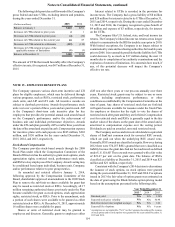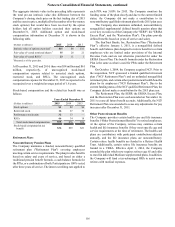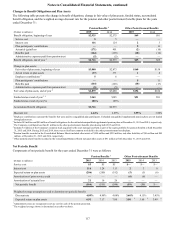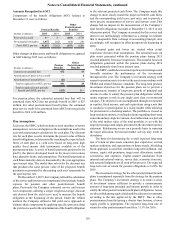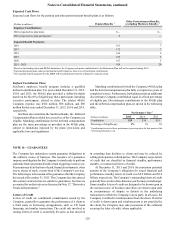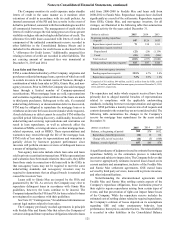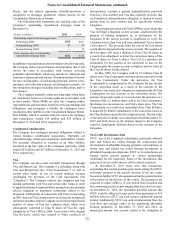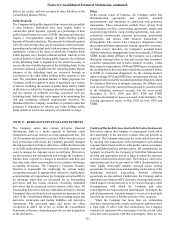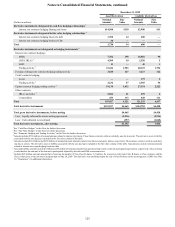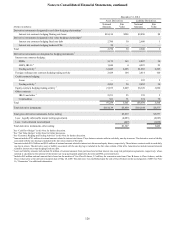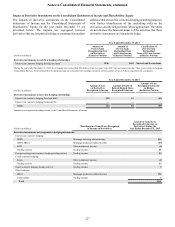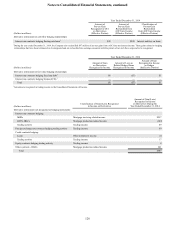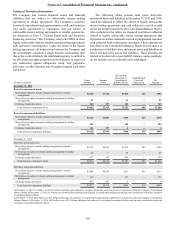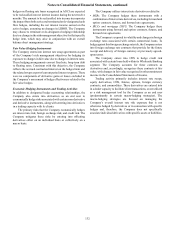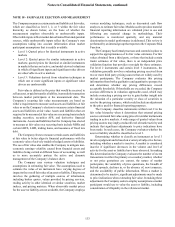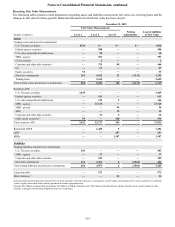SunTrust 2015 Annual Report Download - page 152
Download and view the complete annual report
Please find page 152 of the 2015 SunTrust annual report below. You can navigate through the pages in the report by either clicking on the pages listed below, or by using the keyword search tool below to find specific information within the annual report.Notes to Consolidated Financial Statements, continued
124
value is positive, then the counterparty asset value also reflects
cash collateral held. At December 31, 2015, these net asset
positions were $896 million, reflecting $1.4 billion of net
derivative gains adjusted for cash and other collateral of $463
million that the Company held in relation to these positions. At
December 31, 2014, reported net derivative assets were $1.1
billion, reflecting $1.5 billion of net derivative gains, adjusted
for cash and other collateral of $386 million that the Company
held in relation to these gain positions.
Derivatives also expose the Company to market risk. Market
risk is the adverse effect that a change in market factors, such as
interest rates, currency rates, equity prices, commodity prices,
or implied volatility, has on the value of a derivative. Under an
established risk governance framework, the Company
comprehensively manages the market risk associated with its
derivatives by establishing and monitoring limits on the types
and degree of risk that may be undertaken. The Company
continually measures this risk associated with its derivatives
designated as trading instruments using a VAR methodology.
Other tools and risk measures are also used to actively manage
derivatives risk including scenario analysis and stress testing.
Derivative instruments are priced using observable market
inputs at a mid-market valuation point and take into
consideration appropriate valuation adjustments for collateral,
market liquidity, and counterparty credit risk. For purposes of
determining fair value adjustments to its OTC derivative
positions, the Company takes into consideration the credit profile
and likelihood of default by counterparties and itself, as well as
its net exposure, which considers legally enforceable master
netting agreements and collateral along with remaining
maturities. Generally, the expected loss of each counterparty is
estimated using the Company’s internal risk rating system. The
risk rating system utilizes counterparty-specific PD and LGD
estimates to derive the expected loss. The Company enhances
its approach for determining fair value adjustments of derivatives
by leveraging publicly available counterparty information. In
particular, for purposes of determining the CVA, the Company
incorporates market-based views of counterparty default
probabilities derived from observed credit spreads in the CDS
market when data of acceptable quality is available.
For purposes of estimating the Company’s own credit risk
on derivative liability positions, the DVA, the Company uses
probabilities of default from observable, market-based credit
spreads. The Company adjusted the net fair value of its derivative
contracts for estimates of net counterparty credit risk by
approximately $4 million and $7 million at December 31, 2015
and 2014, respectively. The Company's approach toward
determining fair value adjustments of derivative instruments is
subject to ongoing internal review and enhancement. This review
includes consideration of whether to include a funding valuation
adjustment in the fair value measurement of derivatives, which
relates to the funding cost or benefit associated with
collateralized derivative positions. For additional information on
the Company's fair value measurements, see Note 18, "Fair Value
Election and Measurement."
Currently, the majority of the Company’s derivatives
contain contingencies that relate to the creditworthiness of the
Bank. These contingencies, which are contained in industry
standard master netting agreements, may be considered events
of default. Should the Bank be in default under any of these
provisions, the Bank’s counterparties would be permitted to close
out transactions with the Bank on a net basis, at amounts that
would approximate the fair values of the derivatives, resulting
in a single sum due by one party to the other. The counterparties
would have the right to apply any collateral posted by the Bank
against any net amount owed by the Bank. Additionally, certain
of the Company’s derivative liability positions, totaling $1.1
billion in fair value at both December 31, 2015 and 2014, contain
provisions conditioned on downgrades of the Bank’s credit
rating. These provisions, if triggered, would either give rise to
an ATE that permits the counterparties to close-out net and apply
collateral or, where a CSA is present, require the Bank to post
additional collateral. At December 31, 2015, the Bank carried
senior long-term debt credit ratings of Baal/A-/A- from Moody’s,
S&P, and Fitch, respectively. At December 31, 2015, ATEs have
been triggered for less than $1 million in fair value liabilities.
The maximum additional liability that could be triggered from
ATEs was approximately $13 million at December 31, 2015. At
December 31, 2015, $1.1 billion in fair value of derivative
liabilities were subject to CSAs, against which the Bank has
posted $1.0 billion in collateral, primarily in the form of cash.
At December 31, 2015, if requested by the counterparty pursuant
to the terms of the CSA, the Bank would be required to post
additional collateral of approximately $7 million against these
contracts if the Bank were downgraded to Baa3/BBB-. Further
downgrades to Ba1/BB+ or below do not contain predetermined
collateral posting levels.
Notional and Fair Value of Derivative Positions
The following tables present the Company’s derivative positions
at December 31, 2015 and 2014. The notional amounts in the
tables are presented on a gross basis and have been classified
within derivative assets or derivative liabilities based on the
estimated fair value of the individual contract at December 31,
2015 and 2014. Gross positive and gross negative fair value
amounts associated with respective notional amounts are
presented without consideration of any netting agreements,
including collateral arrangements. Net fair value derivative
amounts are adjusted on an aggregate basis, where applicable,
to take into consideration the effects of legally enforceable
master netting agreements, including any cash collateral
received or paid, and are recognized in trading assets and
derivative instruments or trading liabilities and derivative
instruments on the Consolidated Balance Sheets. For contracts
constituting a combination of options that contain a written
option and a purchased option (such as a collar), the notional
amount of each option is presented separately, with the purchased
notional amount generally being presented as a derivative asset
and the written notional amount being presented as a derivative
liability. For contracts that contain a combination of options, the
fair value is generally presented as a single value with the
purchased notional amount if the combined fair value is positive,
and with the written notional amount if the combined fair value
is negative.


